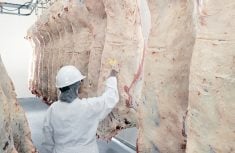Western Canadian feeder cattle prices were $4 to $6 per hundredweight (cwt) higher last week with quality mid-weight cattle showing a week-over-week increase of $10/cwt. Feeding margins have been in positive territory since the beginning of the year, reaching over $200 per head in some cases, which is the main factor driving feeder cattle higher.
Buying interest for grassers is becoming more evident on the 500- to 700-pound weight categories further enhancing demand. Order buyers were once again overwhelmed with business as feedlots are now aggressively shopping after liquidating fall-placed yearlings. Larger-frame exotic steers weighing just over 600 lbs. sold for $214/cwt in central Alberta, leading the charge.
Read Also

U.S. grains: Soybeans rise on China demand hopes; corn and wheat rebound
Chicago Board of Trade soybean, corn and wheat futures rose on Monday on signs of progress towards the end of a record-long U.S. government shutdown, along with expectations of a revival of U.S. soybean exports to China, analysts said.
Indeed, the market is at lofty levels and buyers are paying values based on fall feeding margins rather than looking at the market risks six to eight months forward. However, price insurance programs appear to be growing in popularity, providing confidence at the current price levels for feedlots and backgrounding operations.
Fed cattle in the U.S. southern Plains traded at similar values to last week in the range of $148 to $150/cwt. Alberta packers were on the sidelines, actually lowering bids from seven days earlier, but this did little to stem buying enthusiasm for replacement cattle. Year-to-date slaughter and steer exports to the U.S. for the week ending Feb. 22 were up seven per cent over 2013, so the COOL (country-of-origin labelling) effect may have been media hype, especially when U.S. beef production is running seven per cent below year-ago levels. Beef production is expected to increase in the second quarter in Canada and the U.S., which may weigh on the fed market and spillover into the feeder complex. Seasonally, fed cattle tend to top in late March or early April.
Lethbridge barley prices jumped to $178-$180 per tonne delivered and the industry is projecting a seven to 12 per cent decline in barley acres this spring. The lows may be in place for barley looking forward and the uncertainty in the Black Sea region has caused export values to incorporate a risk premium. The rail backlog may be coming to an end and once 170-car unit trains start moving to Prince Rupert, low-priced barley may be distant memory as barley in central Saskatchewan is the cheapest in the world. This may cause feeding margins to narrow, thereby also weighing on feeder prices in late spring and summer.
Bred cows and replacement heifers were on fire last week and cow-calf producers are finally receiving decent value for older cows. Any mother that can lay a calf one more year is on hold while money from liquidating older cows is being used for replacement heifers. The feeder market is definitely encouraging Canadian expansion and herd rebuilding.
– Jerry Klassen is a commodity market analyst in Winnipeg and maintains an interest in the family feedlot in southern Alberta. He writes an in-depth biweekly commentary, Canadian Feedlot and Cattle Market Analysis, for feedlot operators in Canada. He can be reached by email at [email protected] for questions or comments.












